| Revision as of 13:53, 12 March 2020 view sourceLakshmisreekanth (talk | contribs)Extended confirmed users1,401 edits added referencesTags: Mobile edit Mobile web edit← Previous edit | Revision as of 04:42, 14 March 2020 view source 49.33.129.124 (talk) By checking factsTags: Mobile edit Mobile web editNext edit → | ||
| Line 33: | Line 33: | ||
| | equity = | | equity = | ||
| | owner = ] (61.23%) | | owner = ] (61.23%) | ||
| | subsid = {{Unbulleted list|SBI Life Insurance Ltd|SBI Cards and Payment Services Ltd|] (35%)|] (30 |
| subsid = {{Unbulleted list|SBI Life Insurance Ltd|SBI Cards and Payment Services Ltd|] (35%)|] (30%)<ref>{{Cite news|url=https://theprint.in/economy/sbi-gets-approval-to-invest-rs-7250-crore-in-crisis-hit-yes-bank/379970/|title=SBI gets approval to invest Rs 7,250 crore in crisis-hit Yes Bank|publisher=]|date=2020-03-12|access-date=2020-03-12}}</ref>}} | ||
| | num_employees = 257,252 (March 2019)<ref name="Annual Report 2016-17"/> | | num_employees = 257,252 (March 2019)<ref name="Annual Report 2016-17"/> | ||
| | website = {{URL|https://sbi.co.in/}} | | website = {{URL|https://sbi.co.in/}} | ||
Revision as of 04:42, 14 March 2020
Largest bank in India
 The Banker to Every Indian The Banker to Every Indian | |
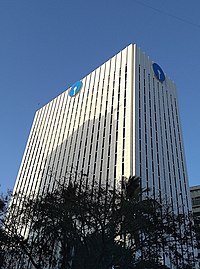 State Bank Bhavan', Nariman Point, Maharashtra State Bank Bhavan', Nariman Point, Maharashtra | |
| Formerly | Imperial Bank of India |
|---|---|
| Company type | Public |
| Traded as | |
| ISIN | INE062A01020 |
| Industry | Banking, financial services |
| Predecessor |
|
| Founded |
|
| Headquarters | State Bank Bhawan, M.C. Road, Nariman Point, Mumbai, Maharashtra, India |
| Number of locations | 22,010 |
| Area served | Worldwide |
| Key people | Rajnish Kumar (Chairman) |
| Products | Retail banking, corporate banking, investment banking, mortgage loans, private banking, wealth management, credit cards, finance and insurance |
| Revenue | |
| Operating income | |
| Net income | |
| Total assets | |
| Owner | Government of India (61.23%) |
| Number of employees | 257,252 (March 2019) |
| Subsidiaries |
|
| Website | sbi |
| Footnotes / references | |
The State Bank of India (SBI) is an Indian multinational, public sector banking and financial services statutory body. It is a government corporation statutory body headquartered in Mumbai, Maharashtra. SBI is ranked as 236th in the Fortune Global 500 list of the world's biggest corporations of 2019. It is the largest bank in India with a 23% market share in assets, besides a share of one-fourth of the total loan and deposits market.
The bank descends from the Bank of Calcutta, founded in 1806, via the Imperial Bank of India, making it the oldest commercial bank in the Indian subcontinent. The Bank of Madras merged into the other two "presidency banks" in British India, the Bank of Calcutta and the Bank of Bombay, to form the Imperial Bank of India, which in turn became the State Bank of India in 1955. The Government of India took control of the Imperial Bank of India in 1955, with Reserve Bank of India (India's central bank) taking a 60% stake, renaming it the State Bank of India.
History


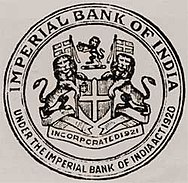
The roots of the State Bank of India lie in the first decade of the 19th century when the Bank of Calcutta later renamed the Bank of Bengal, was established on 2 June 1806. The Bank of Bengal was one of three Presidency banks, the other two being the Bank of Bombay (incorporated on 15 April 1840) and the Bank of Madras (incorporated on 1 July 1843). All three Presidency banks were incorporated as joint stock companies and were the result of royal charters. These three banks received the exclusive right to issue paper currency till 1861 when, with the Paper Currency Act, the right was taken over by the Government of India. The Presidency banks amalgamated on 27 January 1921, and the re-organised banking entity took as its name Imperial Bank of India. The Imperial Bank of India remained a joint stock company but without Government participation.
Pursuant to the provisions of the State Bank of India Act of 1955, the Reserve Bank of India, which is India's central bank, acquired a controlling interest in the Imperial Bank of India. On 1 July 1955, the Imperial Bank of India became the State Bank of India. In 2008, the Government of India acquired the Reserve Bank of India's stake in SBI so as to remove any conflict of interest because the RBI is the country's banking regulatory authority.
In 1959, the government passed the State Bank of India (Subsidiary Banks) Act. This made eight banks that had belonged to princely states into subsidiaries of SBI. This was at the time of the first Five Year Plan, which prioritised the development of rural India. The government integrated these banks into the State Bank of India system to expand its rural outreach. In 1963 SBI merged State Bank of Jaipur (est. 1943) and State Bank of Bikaner (est.1944).
SBI has acquired local banks in rescues. The first was the Bank of Bihar (est. 1911), which SBI acquired in 1969, together with its 28 branches. The next year SBI acquired National Bank of Lahore (est. 1942), which had 24 branches. Five years later, in 1975, SBI acquired Krishnaram Baldeo Bank, which had been established in 1916 in Gwalior State, under the patronage of Maharaja Madho Rao Scindia. The bank had been the Dukan Pichadi, a small moneylender, owned by the Maharaja. The new bank's first manager was Jall N. Broacha, a Parsi. In 1985, SBI acquired the Bank of Cochin in Kerala, which had 120 branches. SBI was the acquirer as its affiliate, the State Bank of Travancore, already had an extensive network in Kerala.
There was, even before it actually happened, a proposal to merge all the associate banks into SBI to create a single very large bank and streamline operations.
The first step towards unification occurred on 13 August 2008 when State Bank of Saurashtra merged with SBI, reducing the number of associate state banks from seven to six. On 19 June 2009, the SBI board approved the absorption of State Bank of Indore, in which SBI held 98.3%. (Individuals who held the shares prior to its takeover by the government held the balance of 1.7%.)
The acquisition of State Bank of Indore added 470 branches to SBI's existing network of branches. Also, following the acquisition, SBI's total assets approached ₹10 trillion. The total assets of SBI and the State Bank of Indore were ₹9,981,190 million as of March 2009. The process of merging of State Bank of Indore was completed by April 2010, and the SBIndore branches started functioning as SBI branches on 26 August 2010.
On 7 October 2013, Arundhati Bhattacharya became the first woman to be appointed Chairperson of the bank. Mrs. Bhattacharya received an extension of two years of service to merge into SBI the five remaining associate banks.
Operations
SBI provides a range of banking products through its network of branches in India and overseas, including products aimed at non-resident Indians (NRIs). SBI has 16 regional hubs and 57 zonal offices that are located at important cities throughout India.
Domestic presence
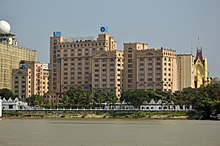
SBI has over 24000 branches in India. In the financial year 2012–13, its revenue was ₹2.005 trillion (US$23 billion), out of which domestic operations contributed to 95.35% of revenue. Similarly, domestic operations contributed to 88.37% of total profits for the same financial year.
Under the Pradhan Mantri Jan Dhan Yojana of financial inclusion launched by Government in August 2014, SBI held 11,300 camps and opened over 3 million accounts by September, which included 2.1 million accounts in rural areas and 1.57 million accounts in urban areas.
International presence

As of 2014–15, the bank had 191 overseas offices spread over 36 countries having the largest presence in foreign markets among Indian banks.
SBI operates several foreign subsidiaries or affiliates.
In 1989, SBI established an offshore bank, State Bank of India International (Mauritius) Ltd. This then amalgamated with The Indian Ocean International Bank (which had been doing retail banking in Mauritius since 1979) to form SBI (Mauritius) Ltd. Today, SBI (Mauritius) Ltd has 14 branches – 13 retail branches and 1 global business branch at Ebene in Mauritius. SBI Sri Lanka now has three branches located in Colombo, Kandy and Jaffna. The Jaffna branch was opened on 9 September 2013. SBI Sri Lanka is the oldest bank in Sri Lanka; it was founded in 1864.

In 1982, the bank established a subsidiary, State Bank of India, which now has ten branches—nine branches in the state of California and one in Washington, D.C. The 10th branch was opened in Fremont, California on 28 March 2011. The other eight branches in California are located in Los Angeles, Artesia, San Jose, Canoga Park, Fresno, San Diego, Tustin and Bakersfield.
In Nigeria, SBI operates as INMB Bank. This bank began in 1981 as the Indo–Nigerian Merchant Bank and received permission in 2002 to commence retail banking. It now has five branches in Nigeria.
In Nepal, SBI owns 55% of "Nepal SBI Bank Limited". (The state-owned Employees Provident Fund of Nepal owns 15% and the general public owns the remaining 30%.) Nepal SBI Bank Limited has branches throughout the country.
In Moscow, SBI owns 60% of Commercial Bank of India, with Canara Bank owning the rest.
In Indonesia, it owns 76% of PT Bank Indo Monex.
The State Bank of India already has a branch in Shanghai and plans to open one in Tianjin.
In Kenya, State Bank of India owns 76% of Giro Commercial Bank, which it acquired for US$8 million in October 2005.
In January 2016, SBI opened its first branch in Seoul, South Korea.
Former Associate Banks
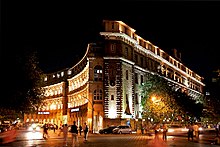
SBI acquired the control of seven banks in 1960. They were the seven regional banks of former Indian princely states. They were renamed, prefixing them with 'State Bank of'. These seven banks were State Bank of Bikaner and Jaipur (SBBJ), State Bank of Hyderabad (SBH), State Bank of Indore (SBN), State Bank of Mysore (SBM), State Bank of Patiala (SBP), State Bank of Saurashtra (SBS) and State Bank of Travancore (SBT). All these banks were given the same logo as the parent bank, SBI. The State Bank of India and all its associate banks used the same blue Keyhole logo. The State Bank of India wordmark usually had one standard typeface, but also utilized other typefaces. The wordmark now has the keyhole logo followed by "SBI".
The plans for making SBI a single very large bank by merging the associate banks started in 2008, and in September the same year, SBS merged with SBI. The very next year, State Bank of Indore (SBN) also merged.
Following a merger process, the merger of the 5 remaining associate banks, (viz. State Bank of Bikaner and Jaipur, State Bank of Hyderabad, State Bank of Mysore, State Bank of Patiala, State Bank of Travancore); and the Bharatiya Mahila Bank) with the SBI was given an in-principle approval by the Union Cabinet on 15 June 2016. This came a month after the SBI board had, on 17 May 2016, cleared a proposal to merge its five associate banks and Bharatiya Mahila Bank with itself.
On 15 February 2017, the Union Cabinet approved the merger of five associate banks with SBI. An analyst foresaw an initial negative impact as a result of different pension liability provisions and accounting policies for bad loans.
The merger went into effect from 1 April 2017.

Non-banking subsidiaries
Apart from five of its associate banks (merged with SBI since 1 April 2017), SBI's non-banking subsidiaries include:
- SBI Capital Markets Ltd
- SBI Cards & Payments Services Pvt. Ltd. (SBICPSL)
- SBI Life Insurance Company Limited
In March 2001, SBI (with 74% of the total capital), joined with BNP Paribas (with 26% of the remaining capital), to form a joint venture life insurance company named SBI Life Insurance company Ltd.
Other SBI service points
As of 31 March 2017, the SBI group had 59,291 ATMs. Since November 2017, SBI also offers an integrated digital banking platform named YONO.
Listings and shareholding
As on 31 March 2017, Government of India held around 61.23% equity shares in SBI. The Life Insurance Corporation of India, itself state-owned, is the largest non-promoter shareholder in the company with 8.82% shareholding.
| Shareholders | Shareholding |
|---|---|
| Promoters: Government of India | 54.23% |
| FIIs/GDRs/OCBs/NRIs | 18.17% |
| Banks & Insurance Companies | 10.00% |
| Mutual Funds & UTI | 8.29% |
| Others | 9.31% |
| Total | 100.0% |
The equity shares of SBI are listed on the Bombay Stock Exchange, where it is a constituent of the BSE SENSEX index, and the National Stock Exchange of India, where it is a constituent of the CNX Nifty. Its Global Depository Receipts (GDRs) are listed on the London Stock Exchange.
State Bank Of India ready to acquire 49% of the share of Yes Bank. Rs 2,400 crore investment would be involved in buying 49% stake if it goes alone in stake.
Employees
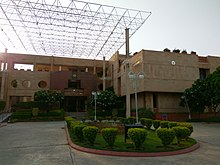
SBI is one of the largest employers in the country with 209,567 employees as on 31 March 2017, out of which 23% were female employees and 3,179 (1.5%) were employees with disabilities. On the same date, SBI had 37,875 Scheduled Castes (18%), 17,069 Scheduled Tribes (8.1%) and 39,709 Other Backward Classes (18.9%) employees. The percentage of Officers, Associates and Subordinates was 38.6%, 44.3% and 16.9% respectively on the same date. Around 13,000 employees joined the Bank in FY 2016–17. Each employee contributed a net profit of ₹511,000 (US$6,000) during FY 2016–17.
Recent awards and recognition
- SBI was ranked 216th in the Fortune Global 500 rankings of the world's biggest corporations for the year 2018.
- SBI was 50th most trusted brand in India as per the Brand Trust Report 2013, an annual study conducted by Trust Research Advisory, a brand analytics company and subsequently, in the Brand Trust Report 2014, SBI finished as India's 19th most trusted brand in India.
See also
- List of largest banks
- List of companies of India
- List of largest companies by revenue
- List of corporations by market capitalization
- Make in India
- Forbes Global 2000
- Fortune India 500
References
- ^ "Annual Report 2018-19 of State Bank of India". Archived from the original on 18 July 2019. Retrieved 18 July 2019.
- "SBI gets approval to invest Rs 7,250 crore in crisis-hit Yes Bank". The Print. 12 March 2020. Retrieved 12 March 2020.
- "State Bank of India Consolidated Yearly Results, State Bank of India Financial Statement & Accounts". www.moneycontrol.com. Archived from the original on 2 July 2017. Retrieved 26 June 2017.
- "State Bank of India Yearly Results, State Bank of India Financial Statement & Accounts". www.moneycontrol.com. Archived from the original on 20 July 2017. Retrieved 26 June 2017.
- "From Imperial Bank to State Bank" (PDF). Archived (PDF) from the original on 30 October 2013. Retrieved 28 June 2017.
- "Fortune Global 500 list". Archived from the original on 7 August 2019. Retrieved 18 October 2019.
- "Away from the public gaze, State Bank of India is preparing to unleash a revolution". Archived from the original on 22 May 2018. Retrieved 22 May 2018.
- Rajesh. Banking Theory Law N Practice. Tata McGraw-Hill Education. p. 8. Retrieved 4 November 2014.
- "Indian Banks' Association". Iba.org.in. 23 April 2005. Archived from the original on 21 July 2011. Retrieved 21 December 2010.
- Business Standard (21 June 2010). "Approvals for State Bank of Indore merger by July: SBI". Archived from the original on 8 July 2011. Retrieved 28 June 2010.
{{cite web}}:|author=has generic name (help) - Economic Times (26 August 2010). "State Bank of Indore branches to become SBI units from Aug 26 : SBI". The Times of India. Archived from the original on 8 October 2016. Retrieved 26 August 2010.
- "Arundhati Bhattacharya, the first woman to head SBI". Archived from the original on 3 December 2013. Retrieved 8 October 2013.
- ^ "Fortune 'Global 500' 2016:State Bank of India". CNN. Archived from the original on 6 January 2020. Retrieved 10 October 2016.
{{cite news}}:|archive-date=/|archive-url=timestamp mismatch; 25 September 2016 suggested (help) - "SBI takes lead in opening bank accounts under Jan Dhan Yojana". The Economic Times. 11 September 2014. Archived from the original on 21 September 2014. Retrieved 30 September 2014.
- "SBI Annual Report 2014-15". State Bank of India. Archived from the original on 26 November 2015. Retrieved 14 January 2016.
- Bank to Grow with Archived 2 May 2017 at the Wayback Machine. SBI Mauritius. Retrieved on 26 December 2018.
- "State Bank of India set to open second branch in China". The Hindu. Retrieved 1 June 2017.
- "State Bank of India Acquired 76% Shareholding in Giro Commercial Bank in 2005". Accessmylibrary.com. 8 October 2005. Archived from the original on 23 October 2012. Retrieved 21 December 2010.
- Iyer, Aparna (17 May 2016). "SBI merger: India may soon have a global Top 50 bank". Archived from the original on 30 June 2016. Retrieved 1 July 2016.
- "Five associate banks to merge with SBI". 18 May 2016. Archived from the original on 21 June 2016. Retrieved 1 July 2016 – via The Hindu.
- "Archived copy". Archived from the original on 30 August 2019. Retrieved 30 August 2019.
{{cite web}}: CS1 maint: archived copy as title (link) - "Archived copy". Archived from the original on 30 August 2019. Retrieved 30 August 2019.
{{cite web}}: CS1 maint: archived copy as title (link) - "Archived copy". Archived from the original on 19 February 2017. Retrieved 18 February 2017.
{{cite web}}: CS1 maint: archived copy as title (link) - "Archived copy". Archived from the original on 30 August 2019. Retrieved 30 August 2019.
{{cite web}}: CS1 maint: archived copy as title (link) - "Archived copy". Archived from the original on 30 August 2019. Retrieved 30 August 2019.
{{cite web}}: CS1 maint: archived copy as title (link) - "Archived copy". Archived from the original on 1 April 2017. Retrieved 30 August 2019.
{{cite web}}: CS1 maint: archived copy as title (link) - "Reserve Bank of India List of ATM's and POS". Archived from the original on 26 August 2017.
- "Stake in PSBs: LIC holding drops as stress mounts". The Indian Express. 15 February 2016. Archived from the original on 4 June 2017. Retrieved 28 March 2017.
- "State Bank of India". BSEindia.com. Archived from the original on 2 November 2013. Retrieved 11 October 2013.
- "Scripwise Weightages in S&P BSE SENSEX". BSE India. Archived from the original on 1 December 2015. Retrieved 11 October 2013.
- "State Bank of India". NSE India. Archived from the original on 2 December 2013. Retrieved 11 October 2013.
- "Download List of CNX Nifty stocks (.csv)". NSE India. Archived from the original on 13 October 2013. Retrieved 11 October 2013.
- "SBID State Bank of India GDR (Each Rep 2 SHS INR10)". London Stock Exchange. 11 October 1996. Archived from the original on 17 September 2013. Retrieved 11 October 2013.
- "Brand Mahatma lags behind Sachin, Aamir: Study". India Today. 28 January 2011. Archived from the original on 2 December 2013. Retrieved 10 October 2013.
- "The Economic Times". Archived from the original on 31 October 2014.
- "Brand Trust Report 2014". Archived from the original on 24 October 2014.
External links
- Official website
- Business data for State Bank of India:
| Institutes |
| ||||||||||||||||||||||||||
|---|---|---|---|---|---|---|---|---|---|---|---|---|---|---|---|---|---|---|---|---|---|---|---|---|---|---|---|
| Public-sector banks | |||||||||||||||||||||||||||
| Private-sector banks | |||||||||||||||||||||||||||
| Foreign banks |
| ||||||||||||||||||||||||||
| Small finance banks | |||||||||||||||||||||||||||
| Payments banks |
| ||||||||||||||||||||||||||
| Cooperative banks | |||||||||||||||||||||||||||
| Regional rural banks |
| ||||||||||||||||||||||||||
| Defunct banks |
| ||||||||||||||||||||||||||
| Networks |
| ||||||||||||||||||||||||||
| Cards | |||||||||||||||||||||||||||
| Online transfers | |||||||||||||||||||||||||||
| Payment service providers |
| ||||||||||||||||||||||||||
| Related topics |
| ||||||||||||||||||||||||||
|
|
| State Bank of India Asia | |
|---|---|
| Sovereign states |
|
| States with limited recognition | |
| Dependencies and other territories | |
- State Bank of India
- Banks based in Mumbai
- Banks established in 1955
- Financial services companies established in 1955
- Companies nationalised by the Government of India
- Companies listed on the Bombay Stock Exchange
- BSE SENSEX
- CNX Nifty
- Multinational companies headquartered in India
- 1955 establishments in India
- Public Sector Banks in India